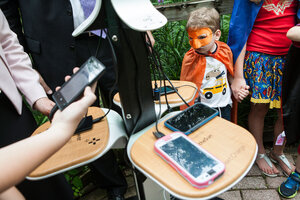How parenting best practices went from 'screen time' to boundary setting
As smartphones and other technology become ubiquitous, parents and teachers must change their approach to teaching tech safety, says the American Academy of Pediatrics.

A young 'superhero' looks on as cell phones are charged on the solar NRG Energy Street Charge portable power charging station at the Houston Children's Museum on June 18, 2015. As smartphones and other technology become more ubiquitous in children's lives, parents and teachers must change their approach to teaching tech safety, experts say.
Scott Dalton/Invision for NRG/AP/File
When the American Academy of Pediatrics (AAP) met in 2015 to begin updating the already 4-year-old tech guidelines for parents, they started with a new premise: The media-drenched world of iPads and Playstations is "just another environment."
"What has happened over time is that media devices have become ubiquitous in almost every environment, and at almost every age," says David Hill, chair of the AAP Council on Communications and Media Executive Committee. "As we get more information about what the implications of this ubiquity are, hopefully we’re better able to provide guidelines that matches the reality."
Rather than regimented limits to screen time, including an earlier suggestion to limit children's access to no more than two hours daily, a commentary released in October emphasized that parents can teach children to use technology appropriately.
"Digital life begins at a young age, and so must parental guidance," the authors wrote. "Children who are 'growing up digital' should learn healthy concepts of digital citizenship."
With screens on nearly every surface, pediatricians are increasingly urging parents not to try to ignore or remove technology, but rather to include good online practices as part of the home curriculum.
"Sometimes the parents' natural inclination is just to take away the phone," says Catherine Bradshaw of the University of Virginia in Charlottesville, who helped conduct a study on cyberbullying with the National Academies Of Sciences, Engineering, and Medicine.
Instead, she says, parents need to "have a discussion about how [children] are handling themselves online and what to do when things go wrong."
Many parents have surrendered to the digital era, abandoning all attempts to micromanage screen time. Instead, their children explore the latest apps or digital platforms with little or no supervision, while the parents tell doctors and teachers that they feel powerless against challenges like smartphone "addiction" or cyberbullying.
“I think families have been sucked into the whole idea of, 'A family that has phones together stays together,' " says David Greenfield, founder of The Center for Internet and Technology Addiction and assistant clinical professor of psychiatry at the University of Connecticut School of Medicine in Farmington.
But what the ads for family plans don't show, he says, is kids sitting in front of their dinner plates, eyes glued to their smartphones.
What Dr. Greenfield calls "parallel play" – spending spend time together without actually interacting – is one example of handing over control to the technology, a problem parents can address by modeling good media habits, including having intentional screen-free time, such as during meals.
Even more worrying are growing trends toward "sexting" and cyberbullying, which likely affects 7 to 15 percent of children and youth, according to a National Academies report. Those and other online behaviors are increasingly criminalized, which some experts say simply foists the problem onto the criminal justice system.
Robert Lotter of Newport Beach, Calif., who has worked with law enforcement on tools for online child safety and invented a monitoring app for parents called My Mobile Watchdog, says this approach can disempower the adults in the best position to help: parents.
“We’ve been, over time, shifting [responsibility] to the schools and to the government," Mr. Lotter says. "We need to give that power and responsibility back to the parents, and we need to help them improve things for their children."
The AAP's "just another environment" paradigm can help parents worried about children using YikYak to bully each other anonymously, or send texts until the wee hours.
"Parents need to teach moderated use [of technology], as with other things," says Greenfield. "Eat a few Oreos, but not the package."
Another solution, Lotter says, is to fight out-of-control technology use with technology itself. Parents and school administrators can use virtual private networks or beacons, which prevent devices inside a geographic area – a child's bedroom, a classroom, or the dinner table, for example – from texting or accessing certain high-risk apps.
Emerging technology, he says, can give teachers and parents "the tools they need to make the online environment safe, just as they try and make the physical environment safe."
Cyberbullying does not differ greatly from other forms of bullying, the AAP's Dr. Hill says. Once parents identify the problem, the technological component of cyberbullying can often be neutralized by communication with an internet service provider or site administrator, many of whom consider such activities a violation of user agreements and will readily shut off access to a cyberbully – to end the problem using the very platform on which it began.

